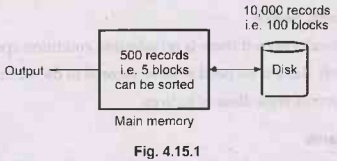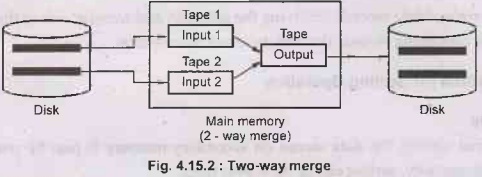Database Management System: Unit IV: Implementation Techniques
Algorithms for Selection,Sorting and Join Operations
Implementation Techniques - Database Management System
For selection operation, the file scan is an important activity. Basically file scan is a based on searching algorithms. These searching algorithms locate and retrieve the records that fulfills a selection condition.
Algorithms for Selection, Sorting and
join Operations
AU: Dec.-19, Marks 3
Algorithm for Selection Operation
For selection operation, the file scan is an important
activity. Basically file scan is a based on searching algorithms. These
searching algorithms locate and retrieve the records that fulfills a selection
condition.
Let us discuss various algorithms used for SELECT Operation based in file scan
Algorithm A1: Linear Search
• Scan each file block and test all
records to see whether they satisfy the selection condition
Cost - br block transfers + 1 seek
Where,
br denotes number of blocks containing records from relation
r
• If selection is on a key attribute, can stop on
finding record
Cost = (br/2) block transfers + 1 seek
• Advantages of Linear Search
• Linear search works even-if there is no selection condition
specified.
• For linear search, there is no need to have records in the
file in ordered form.
• Linear search works regardless of indices.
Algorithm A2: Binary Search
• Applicable if selection is an equality comparison
on the attribute on which file is ordered.
• Assume that the blocks of a relation are stored
contiguously.
• Cost estimate is nothing but the number of disk
blocks to be scanned.
• Cost of locating the first tuple by a binary search
on the blocks = [log2(br)] x (tT + tS)
Where,
br denotes number of blocks containing records from relation
r
tT is average time required to transfer a block of data, in
seconds
tS is average block access time, in second
• If there are multiple records satisfying the
selection add transfer cost of the number of blocks containing records that
satisfy selection condition.
Algorithm for Sorting Operation
External sorting
• In external sorting, the
data stored on secondary memory is part by part loaded into main memory,
sorting can be done over there.
• The sorted data can be then stored
in the intermediate files. Finally these intermediate files can be merged
repeatedly to get sorted data.
• Thus huge amount of data can be sorted using this
technique.
• The external merge sort is a technique in which the data is loaded in intermediate files. Each intermediate file is sorted independently and then combined or merged to get the sorted data.
For example : Consider that
there are 10,000 records that has to be sorted. Clearly we need to apply
external sorting method. Suppose main memory has a capacity to store 500
records in blocks, with each block size of 100 records

The sorted 5 blocks (i.e. 500 records) are stored in intermediate file.
This process will be repeated 20 times to get all the records sorted in chunks.
In the second step, we start merging a pair of intermediate files in the main memory to get output file.
Multiway merge
• Multiway merge sort is a technique
of merging 'm' sorted lists into single sorted list. The two-way merge is a
special case of multiway merge sort.
Let us understand it with the help of an example.

Example 4.15.1 Sort the following list of elements
using two way merge sort with M = 3. 20, 47, 15, 8, 9, 4, 40, 30, 12, 17, 11,
56, 28, 35.
Solution: As M = 3, we
will break the records in the group of 3 and sort them. Then we will store them
on tape. We will store data on alternate tapes.
Stage I: Sorting phase
1) 20, 47, 15. We arrange in sorted order → 15, 20, 47

2) Read next three records sort them and store them on Tape Tb2
8,9,4→4,8,9

3) Read next three records, sort them and store on tape Tb1.
40,30,12→12,30,40

4) Read next three records, sort them and store on tape Tb2.
17, 11, 56→11, 17, 56

5) Read next two remaining records, sort them and store on Tape Tb1
28, 35→28, 35

Stage II: Merging of runs
The input tapes Tb1 and Tb2 will use two more output tapes Ta1 and Ta2,
for sorting. Finally the sorted data will be on tape Ta1.

We will read the elements from both the tapes Tb1 and Tb2,
compare them and store on Ta1 in sorted order.

Now we will read second blocks from Tb1 and Tb2. Sort the elements and store on Ta2.

Finally read the third block from Tb1 and store in sorted manner on Tal.
We will not compare this block with Ta2 as there is no third block. Hence we
will get

Now compare first blocks of Tal and Ta2 and store sorted
elements on Tb1.

Now both Tb1 and Tb2 contains only single block each. Sort
the elements from both the blocks and store the result on Ta1.

Thus we get sorted list.
Algorithm
Step 1:
Divide the elements into the blocks of size M. Sort each block and write runs
on disk.
Step 2: Merge two
runs
i) Read first value on each of two runs
ii) Compare and sort
iii) Write on output tape.
Step 3: Repeat the
step 2 and get longer and longer runs on alternate tapes. Finally we will get
single sorted list.
Analysis: The algorithm requires log(N/M) Passes plus initial run
construction pass.
• Initially
1st tape contains N records = M records * N/M runs.
After storing the runs on two tapes, each contains half of
the runs
Two tapes * M_records per run*1/2 (N/M) = = N records
• After merge 1st pass - double the length of runs,
halve the number of runs
Two tapes *2M_records run *1/2*1/2= (N,M) per runs = N records
• After merge 2nd,pass
Two tapes 4 M_records per run *1/2*1/2 *(N,M) runs = N records
• After merge S-th pass
Two tapes * 2S M records per run *(1/2s) (1/2)
(N/M) runs = N records
• After the last merge, there will be only one run
equal to whole file.
2S M = N
2S = N/M
S= log (N/M)
Hence at each pass the N records are processed and we get the time
complexity as O (N log (N/M)).
• The two way merge sort makes use of two input tapes
and two output tapes for sorting the records.
• It works in two stages -
Stage 1: Break the
records into block. Sort individual record with the help of two input tapes.
Stage 2: Merge the
sorted blocks and create a single sorted file with the help of two output
tapes.
Algorithm for Join Operation
• JOIN operation is the most time
consuming operation to process.
• There are Several different algorithms to implement
joins
1. Nested-loop join
2. Block nested-loop join
3. Indexed nested- loop join
4. Merge-join
5. Hash-join
Choice of a particular algorithm is based on cost estimate.
Algorithm For Nested Loop Join
This algorithm is for computing r ![]() Ө
s
Ө
s
Let, r is called the outer relation and s the inner relation of the
join. A
for each tuplet tr in r do begin
for each tuple ts in s do begin
test pair (tr,ts) to see if
they satisfy the join condition
if 0 is satisfied, then, add (tr, ts)
to the result,
end
end
• This algorithm requires no indices and can be used
with any kind of join condition.
• It is expensive since it examines
every pair of tuples in the two relations.
• In the worst case, if there is enough memory only
to hold one block of each relation, the estimated cost is
• nr × bs + br block transfers,
plus nr + br seeks
• If the smaller relation fits
entirely in memory, use that as the inner relation
• Reduces cost to br + bs block
transfers and 2 seeks
• For example Assume the query CUSTOMERS ![]() ORDERS (with join
attribute only being CName)
ORDERS (with join
attribute only being CName)
Number of records of customer: 10000 order: 5000
Number of blocks of customer: 400 order: 100
Formula Used:
(1) nr × bs + br block transfers,
(2) nr + br seeks
r is outer relation and s is inner relation.
With order as outer relation:
nr= 5000 bs= 400, br = 100
5000 × 400 + 100 = 2000100 block transfers and
5000+100 5100 seeks
With customer as the outer relation :
nr =10000, bs =100, br =400
10000 x 100 + 400 = 1000400 block transfers and
10000+400=10400 seeks
If smaller relation (order) fits entirely in memory, the cost estimate will be:
br+bs =500 block transfers
Algorithm For Block Nested Loop Join
Variant of nested-loop join in which every block of inner relation is
paired with every block of outer relation.
This algorithm is for computing r ![]() Ө s
Ө s
Let, r is called the outer relation and s the inner relation of the
join.
for each block Br of r do
for each block Bs of s do
for each tuple tr in Br do
begin
for each tuple ts in Bs do
begin
test pair (tr, ts) to see if
they satisfy the join condition
if Ө is
satisfied, then, add (tr, ts) to the result.
end
end
end
end
Worst case estimate: br
× bs + br block transfers + 2
× br seeks
Each block in the inner relation s is read once for each block in the
outer relation. Best case: br+ bs block transfers + 2
seeks
(3) Merge Join
• In this operation, both the relations are sorted on
their join attributes. Then merged these sorted relations to join them.
• Only equijoin and natural joins are used.
• The cost of merge join is,
br + bs block transfers + [br
/bb] + [bs/bb] seeks + the cost of sorting, if
relations are unsorted.
(4) Hash Join
• In this operation, the hash function h is used to
partition tuples of both the relations.
• h maps A values to {0, 1, ..., n}, where A denotes
the attributes of r and s used in the join.
• Cost of hash join is:
3(br+bs) + 4 x n block transfers + 2([br
/bb] + [bs/bb]) seeks
If the entire build input can be kept in main memory no
partitioning is required Cost estimate goes down to br+bs.
Review Question
Database Management System: Unit IV: Implementation Techniques : Tag: : Implementation Techniques - Database Management System - Algorithms for Selection,Sorting and Join Operations
Related Topics
Related Subjects
Database Management System
CS3492 4th Semester CSE Dept | 2021 Regulation | 4th Semester CSE Dept 2021 Regulation
